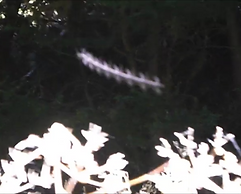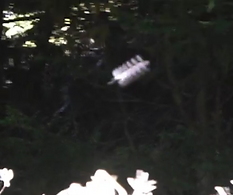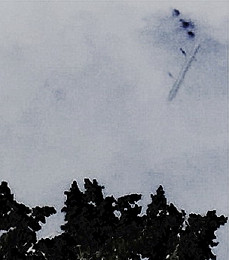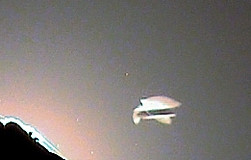Skyfish
Ever since Jose Escamilla first announced the discovery of skyfish there has been an awful lot of controversy surrounding the subject, combined with the total lack of any physical proof. Many people have simply dismissed them as camera artefacts, claiming they are merely the product of long exposure times or interlaced video recording, so for many the case is now closed. During my photographic work in both the infrared and ultraviolet parts of the electromagnetic spectrum I have managed to capture many examples of what I consider to be skyfish, convincing me that they are real, and they do indeed exist.
Insects Elongated by the Filming Process
The most common images I have seen presented as skyfish over the years have been captured on standard cameras and camcorders, and most appear very similar to the images shown below in Figs: 1-6. At first glance this footage does appear to show white rod-like creatures with multiple wing-like appendages running down either side of their bodies, but they are all in fact insects, filmed in and around my garden using a Casio Exilim digital camera in movie-mode. The movie footage was recorded at twenty-nine frames per second, and the insects were only a foot or two away from the camera when filmed. Despite their close proximity to the camera they appeared tiny when viewed through the LCD viewing screen on the camera, so in many cases I had to zoom in a little just to bring them that bit nearer.

Fig: 1

Fig: 4

Fig: 2

Fig: 5

Fig: 3

Fig: 6
Figs: 1-3 show the same insect, in this case a medium sized mosquito, filmed as it flew in and out of the sunlight at the edge of a dark woodland area at the rear of my garden. The multiple repeats of the wings and body are clear to see, and in Fig: 2 and Fig: 3 there is a slight curvature to the image resulting from the insect's circular flight path. The actual rod shape formed from multiple repeats of the insect's body is also white in colour, although this can often vary, ranging from white to black depending on the type of insect and how well its body reflects the sunlight. Another contributing factor to this elongation is the speed of the insect and its distance from the camera lens, and it was found that the elongation sharply diminished the further away it moved from the camera.
Another illusion produced as a result of the elongation is the actual size the rod-like creation appears in the subsequent photograph or video still, as in some cases the image can be made up of half a dozen or more repeats of the insect, making it appear to be several inches long, or in some cases even longer. Figs: 4 and 5 show various small mosquitoes and midges filmed near my garden shed, while Fig: 6 shows a small moth which looks very different when elongated by the movie recording, appearing more like a white baton compared with the mosquitoes and midges with their more reflective and prominent wing structures.
A short video entitled Skyfish - Fact or Fiction? can now be seen on the Quest for the Invisibles You Tube channel. The video takes a look at the skyfish phenomenon, as well as insect elongation due to interlaced video recording, and features various bits of live footage and video stills of both insects and skyfish. A link to the QFTI You Tube channel can be found on the contact page on the last page of this site.
The Skyfish Reality
So if we dismiss these types of elongated insect images from the skyfish equation, then what are we really left with you may ask. Well, the answer to that surely has to be - quite a lot. There are plenty of other images that have also surfaced over the years showing fast moving rod-like objects, and these look nothing like the images presented above in Figs: 1-6, and they appear not to be the product of insect elongation. Many have long slender missile-like bodies with tapering dome-like front ends, as well as fin or wing-like attachments. The first time I became aware that these types of images had even been captured was during a rod/skyfish documentary shown here in the UK some years back, and featuring Jose Escamilla, who was doing some serious research into the phenomenon.
The documentary showed several bits of very convincing footage, including one great example that was filmed at Albany airport New York back in 2002 by Brandon Mowry, a photo journalist who was shooting video for a local news station. The long streamlined anomaly was captured as it flew at speed past a passenger plane which was taking off on the main runway, and although Brandon saw nothing at the time of filming, he later noticed it when reviewing the footage frame by frame. The object appeared so missile-like in appearance that the matter was later reported to airport security, which resulted in the FBI apparently turning up and taking the footage away for further analysis. Photographic evidence of similar objects has been captured in various parts of the world, and footage has even emerged showing these rod-like anomalies flying head-on into a tornado, as well as alongside a NASA rocket heading up into space.
I have also captured similar footage of these high-speed objects in the infrared part of the spectrum, and some examples of these appear below in Figs 7-9. During my work in the ultraviolet between 2011 and 2014 I came across many invisible life-forms, including some that were very fish-like in appearance, having noticeable visible fin and tail sections. In some cases I have even managed to capture multiple images of these invisible "skyfish," at different times, and at different locations, and a few of these are featured below in Figs: 10 - 13.

Fig: 7

Fig: 8

Fig: 9
In Figs 7- 9 we see three different images captured using an infrared converted Canon G10 in movie mode. The 30fps footage was filmed in the summer of 2010 during my early experiments using a cloudbuster as an attraction technique. The tree that appears in all three shots is a one hundred foot lime tree that sits just at the edge of my research area near Oxford, and in all three cases the objects appear to be above this large tree. The camera was positioned on a tripod and aimed above the top of the tree canopy, at exactly the same angle as the cloudbuster was also aiming at the time. The images in Figs 7 and 9 have been inverted as they were very faint and almost ghostly, and this has helped to make the general shape more apparent. The objects all appear to have the same long thin rod-like body, along with noticeable wing or fin-like appendages, although the example shown in Fig: 9 seems to have a more dome-like front end compared with the other examples shown, giving it a more missile-like appearance.

Fig: 10

Fig: 11

Fig: 12
The camcorder stills we see above (Figs 10-12) are taken from my book Quest for the Invisibles, and they show just a few of the fish-like invisible forms I managed to capture in the ultraviolet during 2011/2012. These images are from camcorder footage recorded at 25 fps using a full spectrum Sony DVD-650 Handycam, which was fitted with an X-Nite 330nm ultraviolet pass filter. Nearby rooftops were then utilised to block out the main body of the sun, basically the "sun obliteration technique," creating what I often refer to as the "illumination zone." Anything moving into or through this zone will become totally illuminated by the sun's rays for a fraction of a second, making them visible in the ultraviolet. Once past this point though, many of these objects begin to fade rapidly, eventually becoming invisible again, even to the lens of the ultraviolet sensitive camcorder.
I always focus the camcorder on the edge of the rooftop I am using to block the sun, and then zoom in slightly to bring the edge that bit nearer. This ensures that any object moving in line with the rooftop will be in focus. It is important to keep adjusting the position of the camera or camcorder every now and then to account for the rising of the sun, especially in summer-time when it will rise much higher in the sky. The key is to always keep the sun hidden just below the roofline, so that its rays are only just illuminating the topmost edge.

Fig: 13
D

C

B

A
Fig:13. A-D. Here we see four consecutive frames of an invisible fish-like form, captured on July 18th 2016 at 7.25pm, as it moved from right to left (west to east) above the rooftops adjacent to my main research area. The footage was filmed in HD at 50 fps using a full spectrum converted Sony HDR-PJ620 Handycam, fitted with an external X-Nite 330nm UV pass filter. Rather than moving in the same manner as an aquatic fish might do, this bio-form's plasmatic fish-like body appears to spin through itself, whilst the inner body shape remains constant.
In the first frame (A) the object has just entered into view, with the tail-like portion at the front. By the next frame (B) the main body shape has turned 180 degrees around, and is now facing the other way. In the next frame (C) we see a sudden flurry of movement, and this type of energetic propulsion has been noted several times during my photographic and video work. By the fourth frame (D) the object is again facing the same direction as in the first frame.
This footage was taken from Paper Two of the two-part paper Positive Findings on Constable's Orgonotic Bio-Forms, which is published online at the Journal of Psychiatric Orgone Therapy.
To view the actual live footage of this moving fish-like form......... please follow the link below. Moving fish-like bio-form.
The undeniable presence of these invisible fish-like forms in the atmosphere not only confirms Constable's, Boccone's and Gheorghitza's earlier findings of plasmoidal life in the skies, but also those of Jose Escamilla, who first announced the discovery of skyfish to the world.